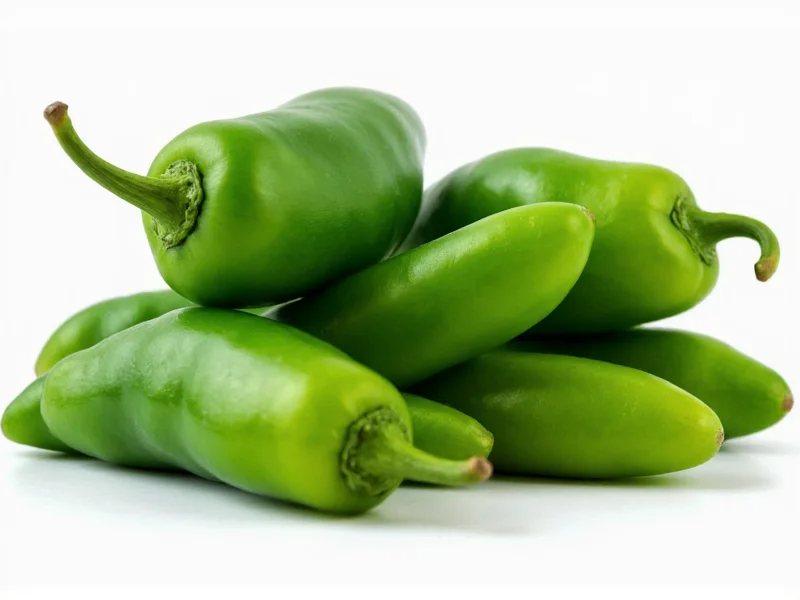When exploring Mexican and Southwestern cooking, understanding the differences between common chili peppers is essential. The jalapeño vs serrano peppers comparison reveals important distinctions that affect everything from heat management to flavor balance in your dishes. While both belong to the Capsicum annuum species, their characteristics create different culinary experiences.
Physical Characteristics Compared
At first glance, these peppers share visual similarities but have distinct physical traits that help identify them. Recognizing these differences prevents recipe mishaps when shopping or harvesting.
| Characteristic | Jalapeño | Serrano |
|---|---|---|
| Size | 2-4 inches long, 1-1.5 inches wide | 1-2.5 inches long, 0.5-1 inch wide |
| Shape | Thick-walled, smooth, slightly curved | Thin-walled, tapered, often straight |
| Color when ripe | Red, but commonly used green | Red, but predominantly used green |
| Surface texture | Smoother skin | More textured, sometimes with small cracks |
Heat Level Differences Explained
The most significant difference in jalapeño vs serrano peppers lies in their heat intensity. Understanding Scoville Heat Units (SHU) helps predict how each pepper will impact your dish.
Jalapeños typically range from 2,500 to 8,000 SHU, placing them in the medium heat category. Most supermarket jalapeños fall toward the lower end of this spectrum. Serranos, however, range from 10,000 to 23,000 SHU—making them potentially nine times hotter than the mildest jalapeños and consistently 2-3 times hotter than average jalapeños.
Heat distribution varies too. Serranos concentrate more capsaicin in their flesh rather than just the seeds and membranes. This means removing seeds from serranos provides less heat reduction than with jalapeños. When comparing fresh serrano vs jalapeño heat levels, always taste a tiny piece first before adding to recipes.
Flavor Profiles and Culinary Applications
Beyond heat, these peppers offer distinct flavor notes that influence their best uses. The jalapeño flavor profile features grassy, vegetal notes with subtle fruitiness, while serranos deliver brighter, more citrusy and floral characteristics.
Chefs selecting between serrano pepper vs jalapeño for salsas consider these factors:
- Jalapeños work best when you want noticeable pepper presence with moderate heat—ideal for nacho cheese, poppers, and fresh pico de gallo
- Serranos shine when intense heat with less vegetable bulk is needed—perfect for blended salsas, hot sauces, and dishes where pepper texture isn't desired
When substituting serrano for jalapeño, use approximately half the amount to maintain similar heat levels. The reverse substitution requires doubling serranos, but this often introduces unwanted texture. For authentic serrano vs jalapeño substitution guidance, consider both heat and texture requirements of your dish.
Growing Conditions and Harvesting
Gardeners comparing jalapeño and serrano pepper plants notice differences in cultivation requirements. Both thrive in warm climates with full sun, but serrano plants typically grow taller (up to 4 feet) with thinner, more delicate stems compared to the stockier 2-3 foot jalapeño plants.
Harvest timing affects flavor development. Jalapeños develop characteristic striations (corking) as they mature, signaling peak flavor. Serranos rarely show this trait. Most home growers harvest both varieties green for traditional applications, though allowing either to ripen to red increases sweetness and slightly reduces perceived heat.
Nutritional Comparison
Both peppers offer impressive nutritional benefits with minimal calories. A single raw jalapeño (14g) contains approximately 4 calories, while a serrano (9g) has about 3 calories. Their nutritional profiles are similar, but differences exist:
- Both provide significant vitamin C (30-40% of daily value per serving)
- Jalapeños contain slightly more vitamin B6 and potassium
- Serranos have marginally higher capsaicin concentration, potentially enhancing metabolic benefits
- Both contain capsaicinoids that may support cardiovascular health
Storage and Preservation Techniques
Proper storage extends the usability of both peppers. Whole jalapeños last 1-2 weeks in the refrigerator's crisper drawer, while serranos stay fresh for 7-10 days due to their thinner walls. For longer preservation:
- Freezing: Both freeze well after roasting or raw (serranos maintain texture better)
- Pickling: Jalapeños are traditional for pickled applications; serranos create more intense pickled peppers
- Drying: Serranos dry more efficiently due to thinner walls, becoming potent chiltepin-style peppers
- Roasting: Jalapeños develop sweeter notes when roasted; serranos retain more heat
When to Choose Each Pepper
Selecting between jalapeño and serrano depends on your specific culinary goals. For authentic Mexican dishes like guacamole or chiles rellenos, jalapeños provide the expected flavor profile with manageable heat. Serranos excel in applications where intense heat without significant vegetable matter is desired—think restaurant-style green salsas or infused oils.
Home cooks exploring jalapeño vs serrano for hot sauce should note that serranos create brighter, cleaner heat, while jalapeños contribute more body and earthiness. Understanding these differences between serrano and jalapeño peppers ensures your dishes achieve the intended flavor and heat balance without unpleasant surprises.











 浙公网安备
33010002000092号
浙公网安备
33010002000092号 浙B2-20120091-4
浙B2-20120091-4